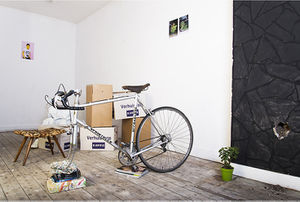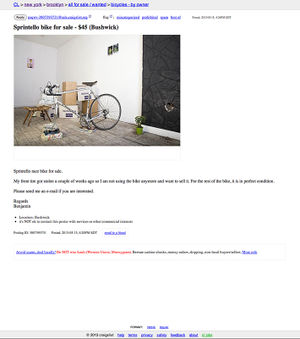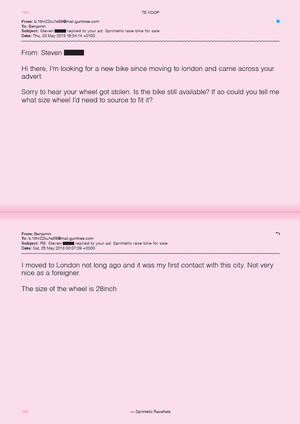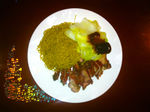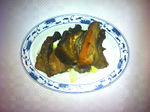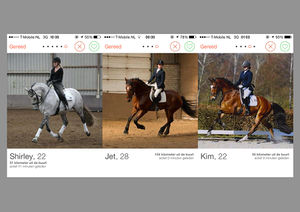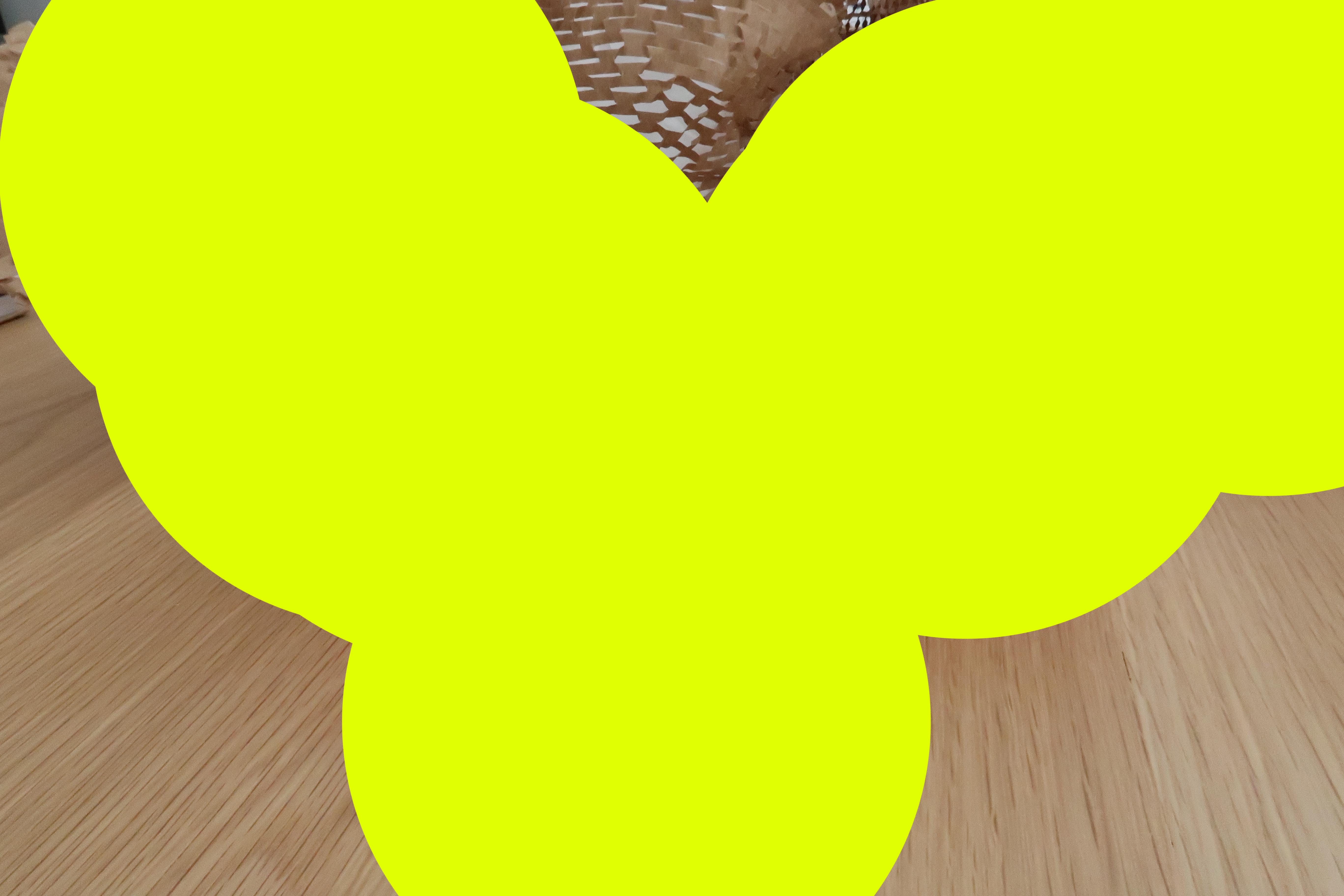Benjamin
FINAL TEXT
INTRO:
Benjamin Li (1985) is a Rotterdam based artist. He studied photography at the Willem de Kooning Academy in Rotterdam and graduated cum laude in 2013 with his project TE KOOP. Currently Li is doing his MDes in Media Design&Communication at the Piet Zwart Institute in Rotterdam. Li's main work involves photography but he also works with video and is experienced in the use of old printing techniques. With his work Li comments on questions around identity, social behavior and online communication.
EARLY WORK: TE KOOP (2013-ongoing)
In my graduation project TE KOOP I infiltrate online commodity markets e.g. Craigslist and Marktplaats. In TE KOOP I make photos of a furnitures or bikes in household settings. Each photo combined with a short description is turned in an advertisement. When I get respondences I try to start conversations with the respondents. In 95% of the cases the conversations stays around the product I seemingly offer. In some cases the conversations transform into an almost friendly conversation. The photos and conversations are equally important, the photos of the items don’t exist without the online content generated and visa versa. When I have an exhibition I show the photos of the items, the conversations with the respondents and screenshots of the original advertisements as they were online on the different commodity markets.
In TE KOOP I investigate the meaning of promotional images, the means of looking at images and the communication between a person who offers and potential buyers. Because I infiltrate commodity markets in different countries, comparisons between countries can be made on the use of language, the amount, length and content of responses as well as demographic differences in population.
I got my inspiration for TE KOOP from my personal experiences on commodity markets and camouflage art. When I was in art school I started to sell and buy items online. I find this still quite stressful. You never know who you are taking with and if you can trust that person. I’m always afraid that I’m being scammed by someone. At the same time I came across the work of Desiree Palmen (1963), Liu Bolin (1973) and Maria Zendrera (1983).
Camouflage plays an important role In the work of Palmen. She explores the notions where our bodies are seen and no longer seen. The purpose of camouflage is to draw our attention to other things in which being not detected is important for the individual. From the vantage point of security cameras Palmen explores the relationship of an individual and its surrounding physical, social and political context (Pratt, 2007). This counts also for the work of Bolin. He combines performance art, photography and protest. The places he chooses for his art work often carry symbols of China's Cultural revolution and the changes in China since the fall of Mao Zedong's regime in 1976. According to Bolin, his works are metaphors for the feeling of anonymity and ostracism he encounters as a contemporary artist in China (Artnet, 2015). Zendrera departs from another point. Her point of departure is that sex sells. In Woman Not Included Zendrera makes use of the context of commodity market where she investigates the nude body in connection to the selling of the product.
This combination of personal experiences, camouflage art and the work of Zendrera are the ingredients for TE KOOP.
CURRENT WORK:
Nr. 39 with Rice:
Nr. 39 with Rice is a project build around an event form an episode of Holland Got Talent in 2013. In the particular event Chinese contestant Xiao Wang is asked by jury member Gordon, a Dutch celebrity known for his singing, if he is going to sing a song called 'Number 39 with Rice' (see: ‘link video’) This in itself is a reference to the extended menus Chinese restaurants often have and the difficult names the dishes carry. Because of that customers order by number instead of name. Wang tried to respond neutrally, but you could see that he was uncomfortable with Gordon's approach.This was also felt by the two other jury members Dan Karaty and Chantal Janzen and the audience. Afterwards numerous people and organizations highlighted this event where some thought it was racist, others saw it as just another harmless joke from Gordon. Nevertheless the issue was highly covered in national media both in newspapers and TV-programmes. Interesting is the response by a group of Dutch-Chinese who had the idea to open a more constructive debate by creating a special offer. The offer includes 39 dishes, in 39 Chinese restaurants with 39% discount (Link: site). This offer and the original event initiated My project Nr. 39 with Rice.
For my projectNr. 39 with Rice I go to Chinese restaurants where I order the Nr. 39-dish. When the dish is served I take a photo of the dish's appearance. The pictures are taken with my Iphone and I leave the flash on. By doing so I try to research if there is an order in the menus of Chinese restaurants. Are all Nr. 39-dishes the same or are they different? Do the menus of Chinese restaurants have a classification system or not? By comparing the pictures I can answer these questions.
I take the pictures on purpose with my Iphone. The introduction of the cellphone changed the pace of our lives. The evolution from a cellphone to a smartphone gave us a ranges of new behaviors i.e. that from taking pictures to surfing on the internet. It changed into a multi-media device that urge us to participate into a system of uploading, sharing and liking. Taking photos has become a daily activity and no subjects or places are save for the smartphone as a camera. It goes even so far that Michelin restaurants are trying to prevent guests from taking pictures of their dishes. They do that because they are afraid of bad publicity or other restaurants using their ideas (Clay, 2014 & Willsher, 2014). To respect the development and integration of the smartphone into our lives, I choose to use this medium.
It is not uncommon to have Chinese restaurant who sell only takeaways. To include these restaurants and their dishes in my project I want to order their food, take it to an artificial setting (i.e. not the restaurant setting) and film myself eating the food. This refers to Mukbang, which literally translates as 'eating broadcast’. Mukbang is a Korean phenomenon where Broadcast Jockeys (BJ) film themselves eating and interacting with an online audience. The audience itself can reward the BJ with balloons which represent the equivalent of 10 dollarcent. Mukbang rapidly became popular in South Korea. Reasons for this are the manny single households in South Korea, voyeurism and the sensuality food can have (Duboc, 2015).
Although my videos are inspired by Mukbang there are some significant differences. First Mukbang is a livestream with a feedback loop, where my videos are not. Instead it is a performance according to certain behavioral rules (script). Second, Mukbang videos are made in a household set in a television studio, my videos are made in a studio. Last, there is no rewarding system connected to my videos.
My aim with Nr. 39 with Rice is to have at least 39 photos of the Nr. 39-dish and 4 videos where I’m eating the dish. In the future I want to extend the project by interviewing restaurant owners and chefs both on the event from Holland Got Talent and Chinese food culture. A possibility is to ask my father to join the project, because he is a chef from origin and knows a lot about flavors. In the end Nr. 39 with Rice will be a project with different media ranging from photography to video to interviews and collaborations.
Tinder:
A second project I’m currently working on is a collection I create from screenshots from Tinder. Tinder is a dating application where people can like or dislike others on their pictures and, if added, a personal description. When two people like each other they become a match. Then they can start a conversation. While using Tinder out of personal interest, I noticed a constant stream of pictures with similar characteristics i.e. girls riding a horse, girls being kissed by a dolphin and girls in front of the Eiffel Tower. I started to collect these pictures by making screenshots of them. At the moment I have a collection of more than 5000 divided over 20 categories.
Some categories are turned into works of art. An example is Walking Horse (2015) where I adjusted pictures of girls on horses and placed them together to form a GIF-video. I ordered the pictures in such a way that the different horses with the different girls on the back seems to galop. This refers to the influential work of Eadweard Muybridge and his study on movements. In the work The Horse in Motion (1878) Muybridge proved that a horse in galop had all its feet from the ground Johnson, 2009.
A second work of me is TinderScape (2015). This is a panorama consisting of a collection of girls facing a mountain area. The edge of the mountains are connected to each other to form a new mountain area. The pictures of the girls facing a mountain area reminds me of the paintings Wanderer above the Sea of Fog (1818) and Chalk Cliffs on Rügen (1818) both made by Caspar David Friedrich. These paintings of Friedrich and the pictures of the girls give the viewer an impression than the wanderer and the girls are looking to the unknown future. The unknown future is striking for Tinder. You never know who you get to see using the application and you don’t if you find your prince on the white horse. So to see the pictures of girls facing a mountain area, the unknown, is a funny coincidence.
My works on Tinder are in line with the works of Richard Prince. Prince uses appropriation in his work. He is best known for the Marlboro Man series from the 1970s. These were taken directly from advertisements (Boucher, 2013). A recent series of work by Prince New Portraits is widely discussed and controversial. The work consists of screenshots of women taken from Instagram. The only thing Prince added was a sentence in which he commented on the photo. The photos are enlarged and were for the first time shown at Gagosian Gallery in 2014 (Johnson, 2014).
Questions are raised whether or not Prince is violating copyright law. In the article of Batista (2015) attorney Arsenault explains that copyright law is more flexible than most people think and that a lot of works can be placed under Fair Use. What needs to be considered when Fair Use is applied is how a work may be perceived, in connection to its purpose or aim and the gain by creating. In New Portraits Prince is not solely copying a photo, in fact he includes the existing commentary, the Instagram interface and his own commentary. It looks like Prince is getting away with this work again like he also won the case against Cariou in 2009 (Boucher, 2013). Although Prince won the lawsuits, a clever response is made by lifestyle brand SuicideGirls. In a response to Prince’s usage of their photo SuicideGirls responded by appropriating the work of Prince by adding a sentence of their own which said ’True Art’. The brand’s founder Missy Suicide, who’s real name is Selena Mooney also commented on the price of $90.000 Prince is asking for the work by asking just 90 dollars for hers. Mooney pointed out that Prince put the works out of reach for almost anyone except the rich and that the even the people portrayed can’t get the work (Risch, 2015).
How my Tinder-collection is going to develop is not clear at this moment. Only two categories are turned into another work. Aside, I need to define my in the work in connection to the girls of whom I use a picture. Where am I commenting on and where am I referring to. The aim is to create the right context and outcome.

